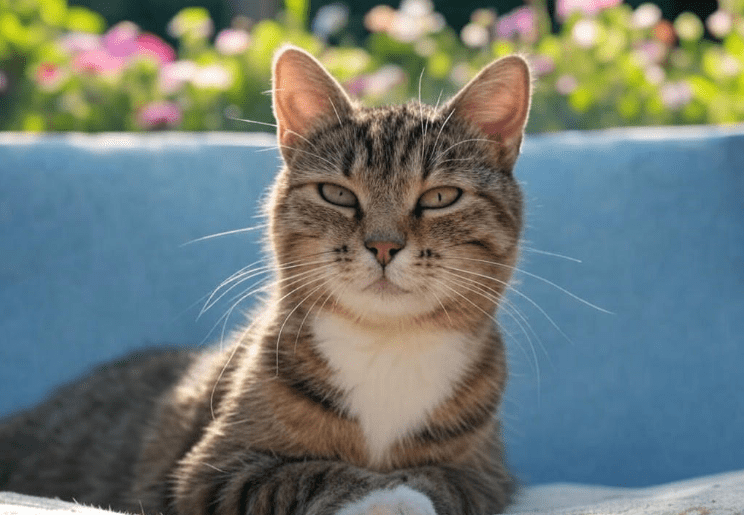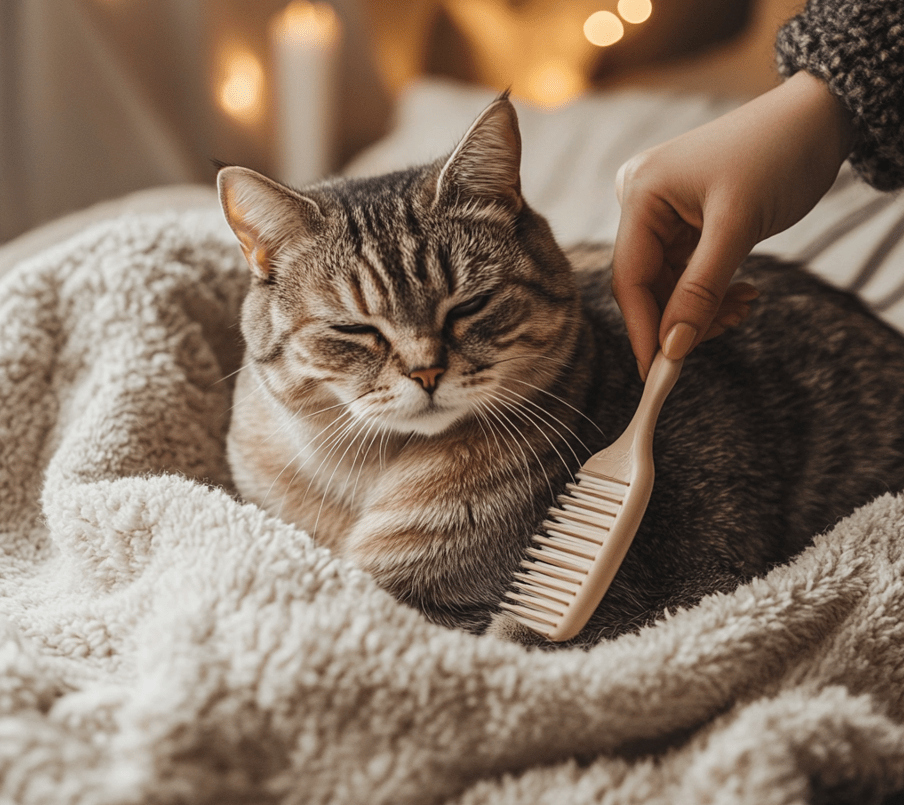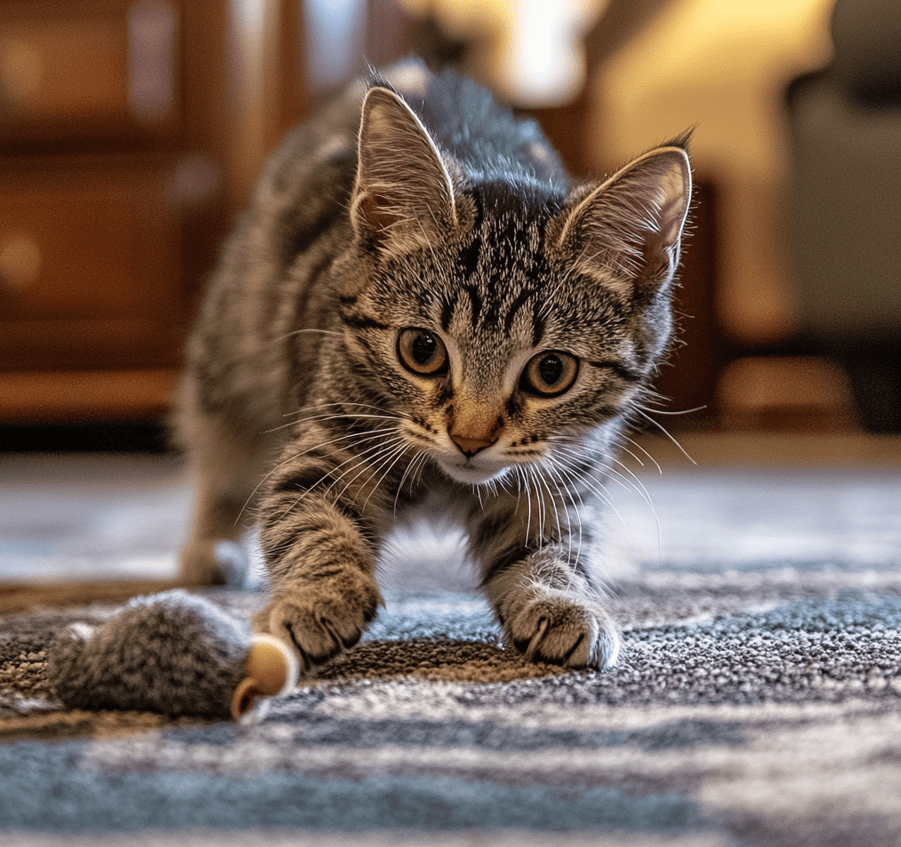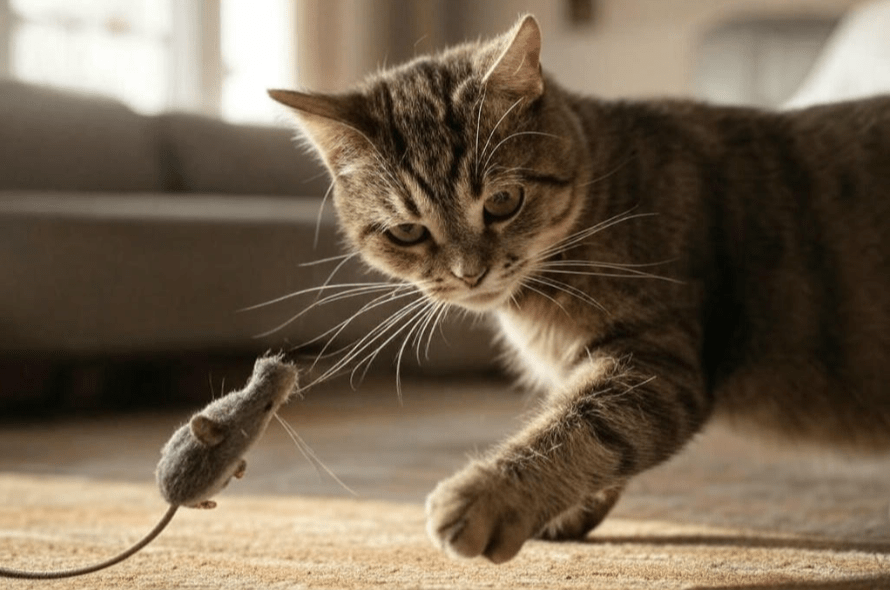
Hair mats in Domestic Shorthairs with thick coats can be a frustrating issue for cat owners. These dense tangles of fur not only affect your cat’s appearance but can also cause discomfort, skin irritation, and even infections if left untreated. Domestic Shorthairs, despite their name, can have thick, plush coats that are prone to matting, especially in areas with high friction or limited grooming. Preventing hair mats in Domestic Shorthairs requires a proactive approach, including regular grooming, proper tools, and an understanding of your cat’s coat and behavior.
In this comprehensive guide, we’ll explore the causes of hair mats, effective prevention strategies, and step-by-step grooming techniques tailored for Domestic Shorthairs with thick coats. We’ll also recommend the best tools, products, and professional services to keep your cat’s coat healthy and mat-free. By the end, you’ll have all the knowledge and tools needed to ensure your Domestic Shorthair’s coat remains smooth, shiny, and comfortable.
Understanding Hair Mats in Domestic Shorthairs
Hair mats are clumps of tangled fur that form when loose hairs intertwine and compact, often in areas that are hard to groom. Domestic Shorthairs with thick coats are particularly susceptible due to their dense undercoats, which trap shed fur and debris. Mats are most common in areas like the belly, armpits, behind the ears, and along the back, where movement or friction encourages tangling.

Why Hair Mats Are a Problem
Discomfort: Mats pull on the skin, causing pain or sensitivity.
Skin Issues: Trapped moisture and debris under mats can lead to infections or hot spots.
Grooming Challenges: Mats make grooming difficult, as cats may resist brushing due to discomfort.
Aesthetic Impact: Mats detract from your cat’s sleek appearance.
Preventing hair mats in Domestic Shorthairs is essential for their health, comfort, and well-being. By addressing the root causes and maintaining a consistent grooming routine, you can keep your cat’s coat in top condition.
Causes of Hair Mats in Domestic Shorthairs with Thick Coats
To prevent hair mats in Domestic Shorthairs, it’s important to understand why they form. Several factors contribute to matting in thick-coated Domestic Shorthairs:
Dense Undercoat: Domestic Shorthairs with thick coats often have a dense undercoat that sheds heavily, especially during seasonal changes. If not removed, shed fur can tangle with live fur, forming mats.
Lack of Regular Grooming: Infrequent brushing allows loose fur and debris to accumulate, increasing the risk of matting.
High-Friction Areas: Areas like the armpits, belly, and hindquarters experience constant movement, which compacts fur into mats.
Moisture and Debris: Wet fur from spills, baths, or outdoor adventures can clump and mat if not dried properly.
Health or Behavioral Issues: Cats that are overweight, arthritic, or stressed may groom less, leading to matting in hard-to-reach areas.
Environmental Factors: Dust, dirt, or sticky substances (like sap) can get trapped in thick coats, encouraging tangles.
By addressing these causes through proper grooming and care, you can significantly reduce the likelihood of hair mats in Domestic Shorthairs.
How to Prevent Hair Mats in Domestic Shorthairs
Preventing hair mats in Domestic Shorthairs requires a combination of regular grooming, the right tools, and attention to your cat’s overall health. Below are detailed strategies to keep your Domestic Shorthair’s thick coat mat-free.

1. Establish a Regular Grooming Routine
Consistent grooming is the cornerstone of preventing hair mats in Domestic Shorthairs. For thick-coated Domestic Shorthairs, aim to groom at least 2–3 times per week, increasing to daily brushing during shedding seasons (spring and fall).
Daily Check: Run your hands over your cat’s coat to feel for small tangles or clumps before they become full mats.
Brushing Sessions: Spend 5–10 minutes brushing your cat, focusing on high-risk areas like the belly, armpits, and hindquarters.
Positive Reinforcement: Use treats or praise to make grooming a pleasant experience, encouraging your cat to cooperate.
2. Choose the Right Grooming Tools
Using the appropriate tools is critical for preventing hair mats in Domestic Shorthairs. Here are the best tools for thick-coated Domestic Shorthairs:
Slicker Brush: A slicker brush with fine, angled bristles is ideal for removing loose fur and preventing tangles. Look for one with soft, flexible pins to avoid scratching your cat’s skin.
Undercoat Rake: Designed for thick coats, an undercoat rake removes loose undercoat fur without damaging the topcoat.
Wide-Tooth Comb: Use a wide-tooth comb to detangle small knots and check for hidden mats.
Dematting Tool: For stubborn tangles, a dematting tool with serrated blades can safely cut through mats without pulling on the skin.
Grooming Gloves: These are great for cats that resist brushing, as they mimic petting while removing loose fur.
Tip: Always brush in the direction of hair growth to avoid discomfort, and start with a wide-tooth comb before moving to a slicker brush.
3. Focus on High-Risk Areas
Pay special attention to areas prone to hair mats in Domestic Shorthairs:
Belly: The soft, dense fur on the belly mats easily due to friction and moisture.
Armpits and Hindquarters: Constant movement in these areas compacts fur.
Behind the Ears: Thin skin and fine fur make this area susceptible to tangles.
Base of the Tail: Shed fur often accumulates here, especially in thick-coated cats.
Gently lift your cat’s limbs or roll them onto their side to access these areas, and use a comb or dematting tool for precision.
4. Keep the Coat Clean and Dry
Moisture and debris contribute to hair mats in Domestic Shorthairs. Follow these tips to maintain a clean coat:
Dry Thoroughly After Baths: Use a pet-safe blow dryer on a low, cool setting to prevent wet fur from clumping.
Remove Debris Promptly: Check your cat’s coat after outdoor time and remove dirt, leaves, or sticky substances.
Use Dry Shampoo: For cats that dislike water, dry shampoo or grooming wipes can keep the coat clean between baths.
5. Monitor Shedding Seasons
Domestic Shorthairs shed heavily in spring and fall, increasing the risk of hair mats in Domestic Shorthairs. During these periods:
1.Increase brushing frequency to daily.
2.Use an undercoat rake or deshedding tool to remove loose fur.
3.Consider a professional grooming session to manage heavy shedding.
6. Address Health and Behavioral Issues
Health or behavioral problems can reduce your cat’s self-grooming, leading to hair mats in Domestic Shorthairs. Watch for:
Obesity: Overweight cats struggle to groom hard-to-reach areas. Consult your vet for a weight management plan.
Arthritis: Joint pain can limit mobility, reducing grooming. Your vet may recommend supplements or pain relief.
Stress or Anxiety: Stressed cats may neglect grooming. Provide a calm environment and consider calming aids like Feliway.
Skin Conditions: Allergies or infections can cause excessive shedding or matting. Seek veterinary advice if you notice skin changes.
7. Use Cat-Safe Grooming Products
Certain products can help prevent hair mats in Domestic Shorthairs by reducing static, softening the coat, or minimizing shedding:
Leave-In Conditioners: These reduce friction and make brushing easier. Choose cat-safe, hypoallergenic formulas.
Anti-Static Sprays: These prevent fur from clumping due to static electricity.
Shedding Supplements: Omega-3 fatty acid supplements can improve coat health and reduce excessive shedding.
Always consult your vet before introducing new products to ensure they’re safe for your Domestic Shorthair.
8. Schedule Professional Grooming When Needed
For thick-coated Domestic Shorthairs, occasional professional grooming can prevent hair mats in Domestic Shorthairs. A professional groomer can:
1.Remove stubborn mats safely.
2.Trim excess fur in high-risk areas (e.g., a sanitary trim around the hindquarters).
3.Perform a thorough deshedding treatment.
Look for groomers experienced with cats, and schedule sessions every 4–6 months, depending on your cat’s coat.
Step-by-Step Guide to Grooming Your Domestic Shorthair
Follow this step-by-step grooming routine to prevent hair mats in Domestic Shorthairs and keep your cat’s thick coat healthy:
Step 1: Prepare Your Tools and Environment
Gather a slicker brush, undercoat rake, wide-tooth comb, dematting tool, and treats.
Choose a quiet, comfortable area where your cat feels relaxed.
Place a non-slip mat or towel on the grooming surface to keep your cat secure.
Step 2: Check for Mats
Run your hands over your cat’s coat, feeling for tangles or clumps.
Use a wide-tooth comb to gently probe high-risk areas like the belly and armpits.
Step 3: Detangle Small Knots
For small tangles, use a dematting tool or wide-tooth comb to gently tease apart the fur.
Work slowly to avoid pulling on the skin, and hold the fur near the skin to reduce discomfort.
Step 4: Brush the Coat
Start with a wide-tooth comb to remove loose fur and debris.
Follow with a slicker brush, working in small sections and brushing in the direction of hair growth.
Use an undercoat rake for dense areas to remove loose undercoat fur.
Step 5: Reward and Monitor
Offer treats or praise throughout the session to keep your cat calm.
Check for skin irritation, redness, or bald spots, and consult a vet if you notice abnormalities.
Step 6: Clean Up
Remove loose fur from tools and dispose of it properly.
Wipe down grooming tools with a pet-safe disinfectant to prevent bacteria buildup.
Tip: Keep sessions short (5–10 minutes) to avoid stressing your cat, and gradually increase duration as they become more comfortable.
Top Recommended Grooming Tools and Products
Based on expert recommendations and user reviews, here are the best tools and products for preventing hair mats in Domestic Shorthairs:

1. Hertzko Self-Cleaning Slicker Brush
Key Features: Retractable bristles for easy cleaning, soft pins for comfort, ergonomic handle.
Best For: Daily brushing to prevent mats and remove loose fur.
Price Range: $15–$20
Why It’s Great: Gentle on sensitive skin and effective for thick coats.
2. Safari Undercoat Rake
Key Features: Dual-row teeth for deep undercoat removal, sturdy design.
Best For: Shedding seasons and dense undercoats.
Price Range: $10–$15
Why It’s Great: Targets loose fur without damaging the topcoat.
3. GoPets Dematting Comb
Key Features: Serrated blades for safe mat removal, rounded edges for skin safety.
Best For: Stubborn tangles and small mats.
Price Range: $20–$25
Why It’s Great: Precise and gentle, ideal for high-risk areas.
4. TropiClean Hypoallergenic Waterless Shampoo
Key Features: No-rinse formula, gentle on skin, reduces static.
Best For: Keeping the coat clean between baths.
Price Range: $10–$15
Why It’s Great: Convenient for cats that dislike water.
5. Nutramax Welactin Omega-3 Supplement
Key Features: High-potency fish oil, supports skin and coat health.
Best For: Reducing shedding and improving coat texture.
Price Range: $20–$30
Why It’s Great: Vet-recommended for long-term coat health.
Common Mistakes to Avoid
To effectively prevent hair mats in Domestic Shorthairs, avoid these common pitfalls:
Brushing Too Infrequently: Waiting too long between grooming sessions allows mats to form.
Using the Wrong Tools: Human brushes or low-quality tools can damage the coat or skin.
Forcing Grooming: Pushing a stressed cat can lead to resistance or injury.
Ignoring Mats: Small tangles can quickly become large, painful mats if not addressed.
Overbathing: Excessive bathing can dry out the coat, increasing matting.
When to Seek Professional Help
If hair mats in Domestic Shorthairs become severe or your cat resists grooming, seek professional help:
Large or Painful Mats: A groomer or vet can safely remove mats that are too tight or close to the skin.
Skin Issues: Mats that cause redness, sores, or infections require veterinary attention.
Behavioral Resistance: If your cat becomes aggressive during grooming, a professional can use calming techniques or sedation if necessary.
Additional Tips for Maintaining a Healthy Coat
Provide a Balanced Diet: High-quality cat food with omega-3s and vitamins supports coat health.
Encourage Self-Grooming: Offer scratching posts or grooming toys to stimulate natural grooming.
Monitor Environmental Factors: Keep your home free of dust and debris that can stick to your cat’s coat.
Regular Vet Checkups: Annual exams can catch health issues that contribute to matting.
Conclusion

Preventing hair mats in Domestic Shorthairs with thick coats is achievable with a consistent grooming routine, the right tools, and attention to your cat’s health and behavior. By brushing regularly, using cat-safe products, and addressing high-risk areas, you can keep your Domestic Shorthair’s coat smooth, healthy, and mat-free. With the strategies and tools outlined in this guide, you’ll be well-equipped to tackle matting and ensure your cat remains comfortable and happy.
Invest time in grooming your Domestic Shorthair today, and enjoy the rewards of a beautiful, tangle-free coat that enhances their health and appearance.
